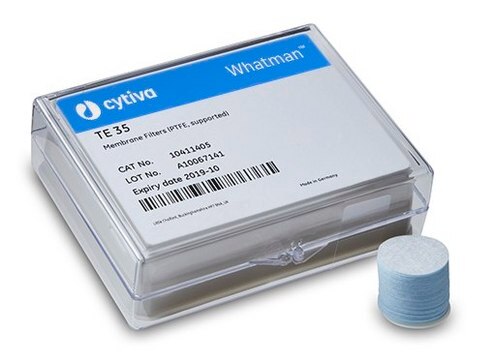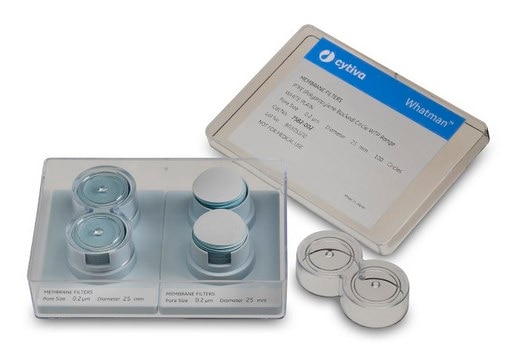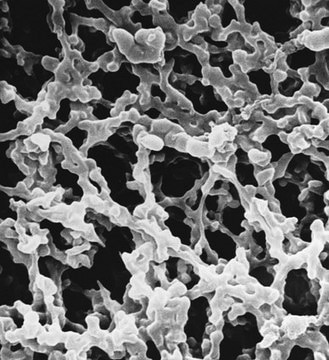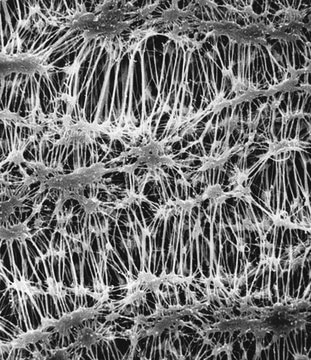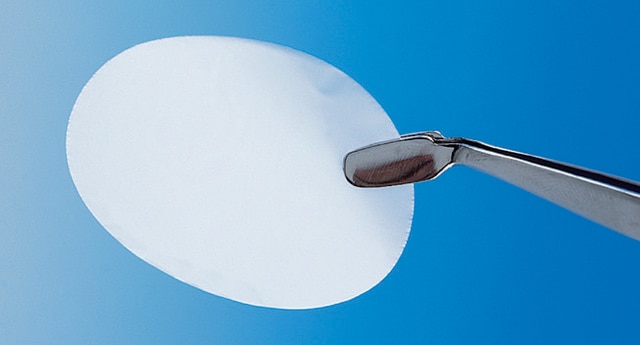WHA7585004
Whatman® membrane filters PTFE
pore size 0.5 μm, diam. 47 mm
Synonym(s):
Whatman filter, Whatman filters, Z746320, syringe filter
Sign Into View Organizational & Contract Pricing
All Photos(1)
About This Item
UNSPSC Code:
40161507
NACRES:
NB.24
Recommended Products
material
PTFE membrane
sterility
non-sterile
packaging
pkg of 100 ea
manufacturer/tradename
Whatman 7585-004
Whatman Article No. 28420777 (US reference)
diam.
47 mm
pore size
0.5 μm
Looking for similar products? Visit Product Comparison Guide
Related Categories
General description
Whatman PTFE membranes are chemically stable and inert. They are suitable for applications involving aggressive organic solvents, strong acids, and alkalis. PTFE membranes are particularly suitable for preparing samples for HPLC analysis. The hydrophobic nature of the membrane also has applications for air and gas sterilization. The membrane is laminated onto a nonwoven polypropylene support web for improved strength and handling and can be used at temperatures up to 120ºC.
Chemically stable and inert PTFE is the membrane of choice for use with aggressive solvents, liquids, and gases that can attack other membranes. It is resistant to most acids, alkalis, and solvents.
Applications
One of the major applications for the PTFE membrane is the clarification of corrosives, solvents, and aggressive fluids. This includes the important requirement in HPLC analysis for sample filtration where any solid particles can cause permanent damage to the column. The 0.5 μm pore size is normally used. Air and gas sterilization make use of the hydrophobic characteristics of PTFE membranes and their ability to stop aqueous aerosols. Usual pore sizes are 0.2 μm and 0.5 μm. Sterile venting of vacuum manifolds, fermentation vessels, and sterile filtrate tanks and containers utilize PTFE 0.2 μm membranes.
WTP membranes use a polypropylene grid as the support material whereas the TE range use a randomly arranged polypropylene support material.
Chemically stable and inert PTFE is the membrane of choice for use with aggressive solvents, liquids, and gases that can attack other membranes. It is resistant to most acids, alkalis, and solvents.
Applications
One of the major applications for the PTFE membrane is the clarification of corrosives, solvents, and aggressive fluids. This includes the important requirement in HPLC analysis for sample filtration where any solid particles can cause permanent damage to the column. The 0.5 μm pore size is normally used. Air and gas sterilization make use of the hydrophobic characteristics of PTFE membranes and their ability to stop aqueous aerosols. Usual pore sizes are 0.2 μm and 0.5 μm. Sterile venting of vacuum manifolds, fermentation vessels, and sterile filtrate tanks and containers utilize PTFE 0.2 μm membranes.
WTP membranes use a polypropylene grid as the support material whereas the TE range use a randomly arranged polypropylene support material.
Other Notes
Field of Use : For internal research use only. Products are not intended for diagnostic use or resale.
Legal Information
Whatman is a registered trademark of Cytiva
Certificates of Analysis (COA)
Search for Certificates of Analysis (COA) by entering the products Lot/Batch Number. Lot and Batch Numbers can be found on a product’s label following the words ‘Lot’ or ‘Batch’.
Already Own This Product?
Find documentation for the products that you have recently purchased in the Document Library.
Customers Also Viewed
Our team of scientists has experience in all areas of research including Life Science, Material Science, Chemical Synthesis, Chromatography, Analytical and many others.
Contact Technical Service